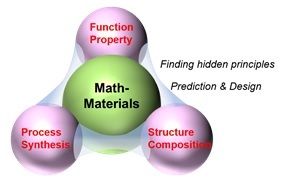|
|
|
|
|
|
| The rapidly evolving branches of materials science need mathematics to translate their accumulating knowledge into a common language. |
TSUKUBA, Japan, June 9, 2016 - (ACN Newswire) - Mathematics has been very successful throughout history in translating complex scientific concepts. Einstein's famous equation E=mc2, for example, describes how mass and energy are interchangeable. But as scientific fields become increasingly complex and specialized, the "language" of mathematics needs to keep pace to develop the mathematical vocabulary necessary to describe both the knowledge and cumulative experience gained by scientists working in the physical world.
 | | Fig. 1: Mathematics may help relate the structure/composition and properties/functions of materials and suggest novel strategies for their synthesis. (c)2016 Motoko Kotani & Susumu Ikeda. |
 | | Fig. 2: Examples showing the power of geometry: relations between continuous and discrete elements in materials, and extraction of discrete geometrical elements. (c)2016 Motoko Kotani & Susumu Ikeda. |
Materials science is a rapidly evolving interdisciplinary field of science that involves the discovery and design of new materials. The field involves understanding the properties and functions of materials at the atomic/molecular scale as well as the macroscopic scale.
Motoko Kotani and Susumu Ikeda from the Advanced Institute for Materials Research, Tohoku University, Japan, have published a vision article in the journal Science and Technology of Advanced Materials (STAM) that emphasizes the need for strong collaboration between materials scientists and mathematicians to break down the barriers of specialized scientific language and create a comprehensive and common understanding of this highly specialized and subdivided field (Fig. 1).
One potential area for fruitful collaboration, for example, is using discrete geometric analysis (graph theory combined with differential geometry) in the study of nanoporous materials, the researchers explain (Fig. 2). Graphs are mathematical structures made up of nodes connected by lines and are used to describe relationships between objects. Nanoporous materials are being used, for example, as membranes to improve energy-storage in capacitors by removing molecules from around ions as they pass through the extremely tiny pores of these materials. The ability to analyze the three-dimensional structure of these pores is important for understanding their physical and chemical properties. Discrete geometric analysis (or graphs taking geometric features into account) could be a powerful tool to investigate the transport of materials through these tiny structures.
Mathematicians have interacted with scientists in other fields over the course of history. But in the 20th century, they underwent a much-needed time of isolation to develop their field, the researchers explain; "after reaching a satisfactory level of advancement, the field should open its doors to seek inspiration." Efforts to fuse mathematics with science generally and materials science specifically are gaining momentum. "It is a good time for mathematics and materials science to encounter each other and interact," the researchers conclude.
For further information please contact:
Prof. Motoko Kotani
Tohoku Univ - WPI-Advanced Institute for Materials Research (WPI-AIMR)
Sendai Miyagi 980-8577, Japan
Tohoku University - Mathematical Institute, Graduate School of Science
Sendai Miyagi 980-8578, Japan
E-mail: kotani@wpi-aimr.tohoku.ac.jp
Prof. Susumu Ikeda
Tohoku Univ - WPI-Advanced Institute for Materials Research (WPI-AIMR)
Sendai Miyagi 980-8577, Japan
E-mail: sikeda@wpi-aimr.tohoku.ac.jp
Article information
Motoko Kotani and Susumu Ikeda: "Materials inspired by Mathematics", Science and Technology of Advanced Materials Vol. 17 (2016) p. 1180233.
http://dx.doi.org/10.1080/14686996.2016.1180233
Journal information
Science and Technology of Advanced Materials (STAM, http://www.tandfonline.com/toc/tsta20/current) is an international open access journal in materials science. The journal covers a broad spectrum of topics, including synthesis, processing, theoretical analysis and experimental characterization of materials. Emphasis is placed on the interdisciplinary nature of materials science and on issues at the forefront of the field, such as energy and environmental issues, as well as medical and bioengineering applications.
For more information about STAM contact
Mikiko Tanifuji
Publishing Director
Science and Technology of Advanced Materials
E-mail: TANIFUJI.Mikiko@nims.go.jp
Fig. 1: Mathematics may help relate the structure/composition and properties/functions of materials and suggest novel strategies for their synthesis. (c)2016 Motoko Kotani & Susumu Ikeda.
http://bit.ly/1ZAvIkI
Fig. 2: Examples showing the power of geometry: relations between continuous and discrete elements in materials, and extraction of discrete geometrical elements. (c)2016 Motoko Kotani & Susumu Ikeda.
http://bit.ly/1tjKaDH
Topic: Research and development
Source: Science and Technology of Advanced Materials
Sectors: Materials & Nanotech, Science & Research
http://www.acnnewswire.com
From the Asia Corporate News Network
Copyright © 2026 ACN Newswire. All rights reserved. A division of Asia Corporate News Network.
|
|
|

|
|
|
|
| Science and Technology of Advanced Materials |
| July 8, 2025 06:48 HKT/SGT |
|
Progress towards potassium-ion batteries |
| June 23, 2025 00:15 HKT/SGT |
|
New method to blend functions for soft electronics |
| May 5, 2025 03:20 HKT/SGT |
|
New Database of Materials Accelerates Electronics Innovation |
| Jan 28, 2025 08:00 HKT/SGT |
|
High-brilliance radiation quickly finds the best composition for half-metal alloys |
| Dec 3, 2024 23:15 HKT/SGT |
|
Machine learning used to optimise polymer production |
| Oct 25, 2024 23:00 HKT/SGT |
|
Machine learning can predict the mechanical properties of polymers |
| July 30, 2024 20:00 HKT/SGT |
|
Dual-action therapy shows promise against aggressive oral cancer |
| Apr 17, 2024 22:00 HKT/SGT |
|
A new spin on materials analysis |
| Apr 12, 2024 18:00 HKT/SGT |
|
Kirigami hydrogels rise from cellulose film |
| Feb 27, 2024 08:00 HKT/SGT |
|
Sensing structure without touching |
| More news >> |
 |
|
|